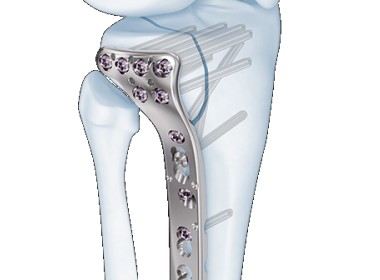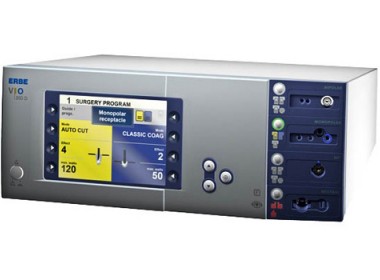Гэмтэл
Дэлхийн Гэмтлийн мэс заслын салбарт тэргүүлэгчдийн нэг Depuy Synthes брэнд нь Johnson & Johnson компаний нэг хэсэг ба дотоод болон гадаад фиксацийн бүтээгдэхүүнүүдээрээ эмч, эмнэлгийн ажилчидад эртнээс танигдсан билээ. DePuy Synthes Trauma салбарын имплант болон багажнуудыг ясны хугарал, согог, урт ясны хавдар зэрэгт хэрэглэж болно. Мөн түүнчлэн энэхүү үйлдвэрлэгч нь дал, гар сарвуу, аарцаг, түнх, эгэмний яс болон тавхайн гэмтлийн имплант зэргийг санал болгодог. DePuy Synthes бүтээгдэхүүнээ үргэлж сайжруулж шинэчилж, чанарын дээд зэргийн баталгаа өгдөг тул дэлхий даяар эмнэлгүүдэд хэрэглэгдсээр ирсэн.
Products
3.5mm VA LCP® Proximal Tibia Plate
.png)
The Synthes 3.5 mm VA-LCP® Proximal Tibia Plate is part of the VA-LCP Periarticular Plating System which merges variable angle locking screw technology with conventional plating techniques.
The 3.5 mm VA-LCP Proximal Tibia Plate System has many similarities to standard locking fixation methods, with a few important improvements. Variable angle locking screws provide the ability to create a fixed-angle construct while also allowing the surgeon the freedom to choose the screw trajectory before “fixing” the angle of the screw. A fixed-angle construct provides advantages in osteopenic bone or multifragmentary bridge-plated fractures where screws do not rely on plate-to-bone compression to resist patient load.
The 3.5 mm VA-LCP Proximal Tibia Plate has variable angle holes in the plate head and neck, along with variable angle Combi holes in the plate shaft that combine a dynamic compression unit (DCU) hole with a variable angle locking screw hole. The variable angle Combi hole provides the flexibility of axial compression and variable angle locking capability throughout the length of the plate shaft.
Indications for Use
The Synthes 3.5 mm VA-LCP Proximal Tibia Plates are intended to treat fractures of the proximal tibia in adults and adolescents in which the growth plates have fused including: simple, comminuted, lateral wedge, depression, medial wedge, bicondylar combination of lateral wedge and depression, periprosthetic, and fractures with associated shaft fractures. Plates can also be used for treatment of nonunions, malunions, tibial osteotomies and osteopenic bone.
Features & Benefits
- Plate includes variable angle locking holes and variable angle COMBI holes
- Plate head includes two rows of variable angle rafting screws allowing placement of the screws to capture posterior medial fragments while also providing the ability to avoid or abut proximal tibial components in periprosthetic fracture treatment
- Plate allows for placement of two variable angle kickstand screws
- In the plate neck, a long hole allows for compression, preliminary fixation, and plate adjustment
- Plate is available in two bends, Small and Large Bend, to accommodate varying tibial anatomies
- System contains 3.5 mm Variable Angle Locking Screws
- Screws can be angled anywhere within a 30° cone around the central axis of the plate hole
- Permits use of minimally invasive surgical technique
Resources
- 3.5 mm VA-LCP Proximal Tibia Plate System Technique Guide
- 3.5 mm VA-LCP Proximal Tibia Plate System Inventory Control Form
MultiLoc Humeral Nail
.png)
Division: Trauma
Category: Intramedullary Nails
MultiLoc Humeral Nails provide a comprehensive system for the treatment of humeral fractures. The new, innovative screw-in-screw technology offers customizable stability for the individual patient.
Indications for Use
The MultiLoc Proximal Humeral Nail (short) is indicated for:
- Fractures of the proximal humerus including 2-part surgical neck fractures, 3-part fractures and 4-part fractures
The MultiLoc Humeral Nail (long) is indicated for:
- Fractures of the proximal humerus including 2-part surgical neck fractures, 3-part fractures and 4-part fractures
- Fractures of the proximal humerus with diaphyseal extension
- Diaphyseal fractures of the humeral shaft
- Impending pathological fractures
Features & Benefits
The system includes several innovative features designed specifically for the clinical needs of humeral nailing
- Straight nail with central insertion point designed to avoid potential insertion through the fracture site
- Unique screw-in-screw option for improved stability*
- Polyethylene inlay for secure screw fixation of the proximal screwsAscending screw option to provide
- support to the calcar
- Bicortical compression feature designed to increase stability in transverse and short oblique fractures
- Multiplanar distal locking for less implant toggling in the short nail
- Improved distal locking designed to be in the safe zone between the median and the radial nerve in the long nail
* Comparative testing is on file at DePuy Synthes. Refer to the TG for details of test. Bench test results do not necessarily reflect clinical performance
Resources
- Inventory Control Form
- Technique Guide
- Design Rationale
- Proximal Numerus Fracture – Plate, Nail or Replace
4.5mm VA-LCP Curved Condylar Plate
.png)
Division: Trauma
Category: Plates and Screws
The Synthes 4.5 mm VA-LCP Curved Condylar Plate is part of the VA-LCP Periarticular Plating System which merges variable angle locking screw technology with conventional plating techniques.
The 4.5 mm VA-LCP Curved Condylar Plate System has many similarities to standard locking fixation methods, with a few important improvements. Variable angle locking screws provide the ability to create a fixed-angle construct while also allowing the surgeon the freedom to choose the screw trajectory before “fixing” the angle of the screw.
A fixed-angle construct provides advantages in osteopenic bone or multifragmentary bridge-plated fractures where screws do not rely on plate-to-bone compression to resist patient load, but function similarly to multiple, small, angled blade plates.
The variable angle locking compression plate (VA-LCP) has variable angle Combi holes in the plate shaft that combine a dynamic compression unit (DCU) hole with a variable angle locking screw hole. The variable angle Combi hole provides the flexibility of axial compression and variable angle locking capability throughout the length of the plate shaft.
Indications for Use
The Synthes 4.5 mm VA-LCP Curved Condylar Plate System is indicated for buttressing multifragmentary distal femur fractures including: supracondylar; intra-articular and extraarticular condylar fractures, periprosthetic fractures, fractures in normal or osteopenic bone, nonunions and malunions.
Features & Benefits
- Provides the flexibility to lock screws in trajectories that can diverge from the central axis of the plate hole
- Plate includes variable angle locking holes and variable angle Combi holes
- System contains 5.0 mm Cannulated and Solid Variable Angle Locking Screws
- Screws can be angled anywhere within a 30° cone around the central axis of the plate hole
- Permits use of minimally invasive surgical techniqueAvailable with 6, 8, 10, 12, 14, 16, 18, 20 or 22
- variable angle Combi holes in the shaft to accommodate fracture patterns that include shaft fractures with articular fragments
- Central hole in the head of the plate is a fixed angle locking hole
Resources
- 4.5 mm VA-LCP Curved Condylar Plate System Inventory Control Form
- 4.5 mm VA-LCP Curved Condylar Plate Technique Guide
- Building on Success - VA-LCP Brochure






